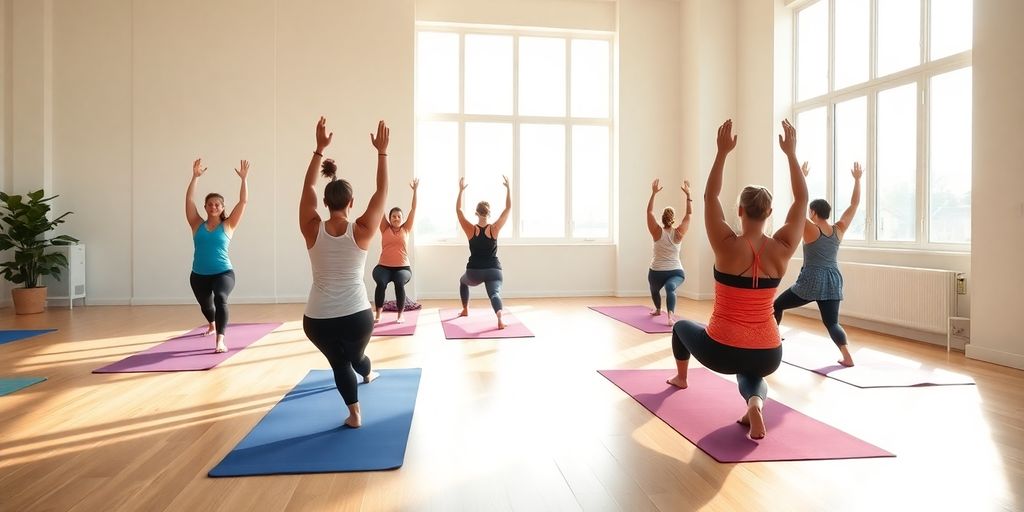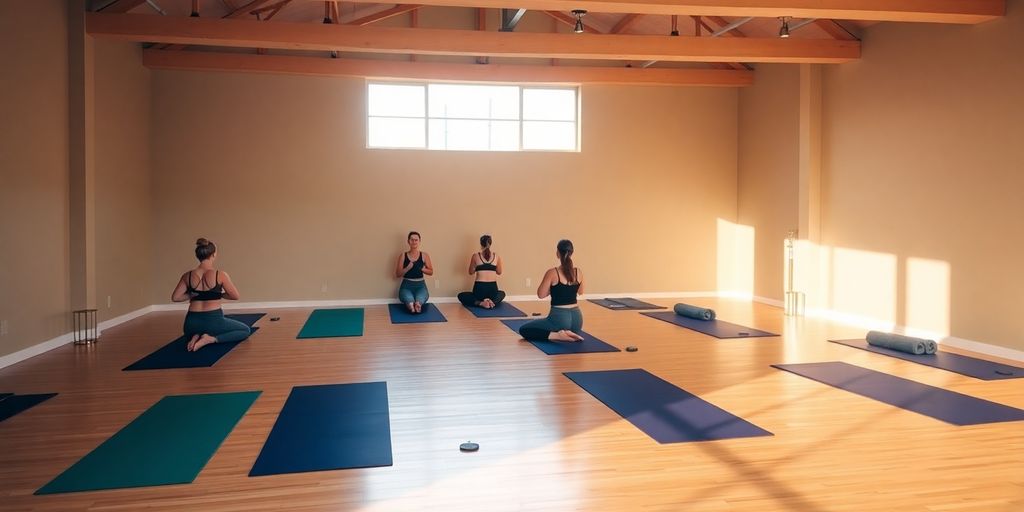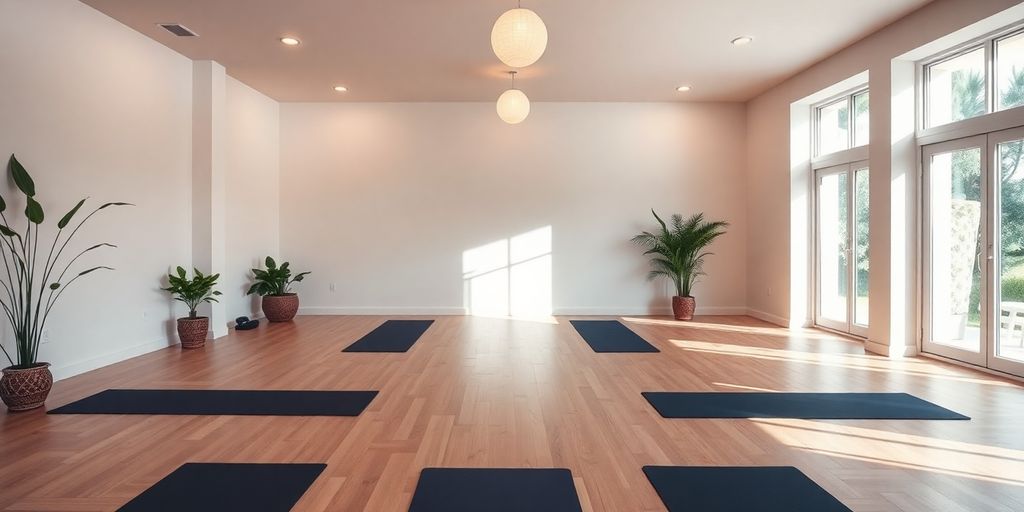
Transform Your Practice: The Ultimate Guide to Live Online Yoga Classes
In recent times, live online yoga classes have become a popular way for instructors to connect with students from all over the globe. This guide is designed to help you navigate the world of virtual yoga, whether you're just starting or looking to refine your teaching methods. We'll cover everything from engaging class structures to marketing strategies, ensuring you have the tools you need to thrive in this new landscape.
Key Takeaways
- Live online yoga classes expand your reach beyond local students.
- Creating an interactive environment keeps students engaged and motivated.
- Using the right technology can enhance the online teaching experience.
- Marketing your classes effectively is essential for attracting new students.
- Building a supportive community helps students feel connected and valued.
Understanding The Virtual Yoga Landscape

Online yoga has changed a lot in recent times. More people are turning to live sessions and experimenting with virtual reality yoga setups, meaning that a lot of long-time teachers have had to switch things up. It’s a bit of a wild ride learning to connect with students when you’re not in the same room.
The Shift To Online Yoga
Many instructors are finding they can reach students in new ways. The move online has been steady, with people opting for classes they can join from home. Online classes let you reach new audiences in surprising ways. Here are a few factors that have pushed this change:
- Easier scheduling
- Lower costs for both teachers and students
- Increased accessibility for people in remote areas
- Flexible class times
Benefits Of Live Online Yoga Classes
Teaching online has its perks. Live sessions mean you can interact with your students in real time, which creates a sense of group effort even when everyone is far apart. Some clear benefits include:
- Real-time feedback during practice
- A growing audience that values convenience
- Saving travel time and expenses
Below is a simple table that breaks down some of the benefits:
| Category | Benefit |
|---|---|
| Accessibility | Easier join-in from anywhere |
| Flexibility | Customizable class timings |
| Interaction | Live feedback and guidance |
Challenges Of Teaching Yoga Online
Not all is smooth sailing even though there are benefits. Many teachers face hurdles that can be unexpected. Technical glitches, a lack of in-person energy, and difficulties in showing modifications clearly are common issues. Here are some major challenges:
- Technology issues like bad internet or unfamiliar software
- Reduced physical presence for spotting and posture corrections
- Building a community when everyone is behind a screen
- Keeping students engaged over a digital platform
When transferring your practice online, remember that every hurdle is a learning moment. Experiment with different approaches and listen to your students’ feedback to keep improving your sessions.
Creating Engaging Live Online Yoga Classes

Designing Your Class Structure
Getting your online class schedule right means more than just picking a time slot, it's about crafting a flow that sets the tone. Start by mapping out your session from welcome to cool down. A clear structure builds confidence and lets students know what to expect. Consider these steps:
- Decide on a starting routine like light stretching.
- Plan a variety of poses or sequences with clear transitions.
- End with a cooldown that allows everyone to return to calm.
Here's a simple table you can use to plan a typical class:
| Segment | Duration | Focus |
|---|---|---|
| Warm-Up | 10 min | Gentle stretching |
| Main Session | 35 min | Pose sequences |
| Cool Down | 15 min | Relaxation work |
Incorporating Interactive Elements
Making your class interactive keeps the energy up and the connection strong. Ask questions, invite student participation, and check in directly during the class. Using tools like real-time chat or hand signals helps everyone feel involved. If some students prefer not to speak up, you might ask them to type in comments. Also, consider Cloudflare security tips when setting up your online platform to make sure it's reliable for every participant.
A couple of quick ideas include:
- Start with a brief introduction round.
- Use polls during the session to get instant feedback.
- Allow moments of open sharing, even if just to say a few words.
Utilizing Technology Effectively
Using the right tech can make a big difference. Before you start, check your equipment and the software you're using for casting the class live. It pays to test your camera, microphone, and lighting so that your students see and hear you clearly.
- Invest in a decent webcam or phone setup.
- Set up a microphone that picks up clear sound.
- Use a stable platform to broadcast your live session.
A smooth tech setup not only minimizes disruptions but also makes students more comfortable, knowing they’re part of a well-run session.
Remember, using a simple checklist before each class can help ensure nothing is missed. By keeping your structures clear and your tech in check, you're ready to deliver an engaging and memorable online yoga experience.
Marketing Your Live Online Yoga Classes
Building Your Online Presence
Creating a solid online image is the first step in attracting students for your live yoga sessions. Start with a simple website that clearly lists your classes, times, and pricing. Keep your branding consistent across all platforms. Your online presence is the bridge that connects you with potential students.
Here are some tips to set up your presence:
- Keep your website updated with a clear schedule
- Use a consistent tone and style in every post
- Share small stories or moments from your classes
Don’t forget to use digital marketing tips to boost your online appeal.
Strategies For Attracting Students
Pulling in new students can be challenging, but setting up some simple strategies can work wonders. Consider offering a free trial class or easy referral incentives. Always invite feedback and use genuine testimonials from happy students.
A clear plan makes a difference. For instance, try these ideas:
- Offer a free 15-minute session to introduce newcomers to your teaching style
- Create a simple referral scheme with discounts for both referrer and new student
- Share student success stories in your newsletter
Below is a brief table summarizing some common tactics:
| Tactic | Benefit |
|---|---|
| Free trial class | Showcases your style |
| Referral discount | Encourages word-of-mouth |
| Student reviews | Builds trust and social proof |
Leveraging Social Media
Social media is a handy tool for boosting your yoga classes. It lets you share quick updates, behind-the-scenes looks, and even live Q&A sessions. Use platforms like Instagram, Facebook, or Twitter to keep in touch with your audience.
A few things to try out on social media:
- Post regular updates about upcoming classes
- Share a few snaps or videos during your session breaks
- Use hashtags to reach a wider audience on each platform
Students often tell me that the real-time connection during live classes makes them feel more involved. They enjoy seeing the little moments that show your authentic approach to teaching.
Remember to naturally mix in your digital marketing tips to complement your content without overwhelming your audience.
Supporting Students In Their Online Journey
Fostering Community Connection
Creating a warm and inclusive online space can really make a difference in how students feel during a session. Start by acknowledging everyone, using names to highlight individual contributions, and organizing moments where participants can share their experiences. Here are a few ideas to help build that connection:
- Greet each student with a simple hello or a nod of recognition.
- Encourage sharing a brief story or experience at the start of the class.
- Use interactive activities that let everyone participate, like a quick round of introductions.
Remember, a strong connection often comes from small, thoughtful details. For extra tips on boosting community vibes, try community building.
Providing Feedback And Support
Giving feedback is a hands-on way to show students you care about their progress. A mix of gentle pointers and genuine praise can go a long way. Here’s a simple approach to offering support during an online yoga session:
- Mention specific improvements and encourage students to work on little adjustments.
- Create a safe space where mistakes are seen as part of the learning process.
- Use both private messages and group shout-outs to recognize effort and progress.
Feedback, when delivered kindly, can turn challenges into stepping stones for growth.
And to break it down quickly, check out this table:
| Step | Action | Outcome |
|---|---|---|
| Notice & Note | Pay close attention and note details | Personal recognition |
| Friendly Reminder | Offer gentle suggestions | Improvement in postures |
| Group Shout-Out | Highlight successes publicly | Boost in class morale |
Encouraging Student Engagement
Active engagement makes online sessions lively and fun. It’s not just about following along; it’s about interacting, asking questions, and energizing the class spirit. Here are a few ways to spark this engagement:
- Invite students to share personal achievements or struggles during the session.
- Ask a few interactive questions periodically to keep the energy up.
- Organize short group challenges or paired exercises to foster peer support.
These actions help transform a routine online class into an engaging, collaborative experience that feels personal and interactive.
Essential Tools For Online Yoga Instruction
This section explains the gear and software needed to run your online yoga sessions from the comfort of your home. For instance, using high-quality tools can make a big difference in keeping your session smooth and clear.
Equipment You Need
When you're setting up your online class area, make sure you have the right gear at hand. A decent camera, a clear microphone, proper lighting, and a stable tripod are the starting points. Here’s a short list to consider:
- A camera that records in HD
- A microphone that picks up clear sound
- Good lighting to make the space look neat
- A tripod or stand for keeping the camera steady
Sometimes it helps to see a quick comparison like this:
| Equipment | Basic Option | Upgrade Option |
|---|---|---|
| Camera | 720p HD | 1080p or 4K |
| Microphone | Wired version | Wireless mic |
| Lighting | Ring light | Softbox setup |
Clear video and sound are what keep your class connected.
Choosing The Right Software
The program you use for streaming or recording plays a big role in your class. You need a platform that allows you to interact in real time and doesn't add too much hassle. Here are a few points to weigh:
- Pick software that supports live interaction
- Choose a tool with a friendly interface
- Make sure it works well on different devices
Sometimes it's worth testing a few free trials to see which software fits best with your style.
Setting Up Your Virtual Studio
Creating your online studio involves more than just technical gear. Clear out a small portion of your home and arrange it so that everything looks neat on camera. Follow these steps:
- Prepare an uncluttered area that feels warm
- Check your camera's angle and test your audio
- Arrange props and lighting to set the mood
A clean, simple setup helps your students stay focused on their practice rather than worrying about distractions.
Tips For Successful Online Teaching
Online yoga teaching is not just about running a series of classes via your computer. It’s about creating a space that feels personal and practical, and knowing that sometimes things go off-plan. Here are some ways to fine-tune your approach for better online sessions.
Creating A Welcoming Environment
Start by making sure your space is clear, simple, and inviting. This doesn’t mean you need a fancy setup, but a quiet spot with a tidy background works best. Consider these pointers:
- Arrange a calm background with minimal clutter
- Use soft, natural lights or proper lighting for a warm look
- Position your camera so that your students feel like you’re right there with them
Keep your space comfortable and inviting – it sets the tone for a positive class.
Adapting Your Teaching Style
Online classes can run a little differently compared to in-person ones. You might need to adjust the pace and explain movements a bit more. Listening to student feedback is key. Some ideas include:
- Slow down your instructions to allow time for understanding
- Introduce variety by switching up your verbal cues and demonstrations
- Ask for feedback during and after class to fine-tune your style
Each group of students might need something a little different, so stay open to trying new things. This flexibility can often make a big difference.
Managing Technical Challenges
Technical glitches are almost inevitable when teaching online, but a few simple steps can keep things running smoother:
| Issue | Quick Fix |
|---|---|
| Audio disturbances | Check your microphone setup |
| Poor video quality | Review your proper lighting and camera position |
| Connection drops | Have a backup internet source |
- Test your equipment before each class
- Keep instructions simple in case you need to troubleshoot mid-class
- Stay calm when tech issues pop up, and let your students know you’re working on it
Teaching online means you’re balancing between giving clear instructions and handling occasional glitches. If you keep these tips in mind, you’re likely to experience fewer hiccups and more rewarding classes.
Expanding Your Reach With Online Yoga
Reaching A Global Audience
Online classes mean you can welcome students from every corner of the world. When you teach online, your audience isn’t limited by local geography. This opens up opportunities to interact with people from different cultures, experiences, and backgrounds. In fact, many instructors have seen a boost in participation when they put their classes on a global stage. Relying on secure online tools also means that every session can run smoothly.
- Reach students in multiple time zones
- Connect diverse communities
- Grow your teaching network
Flexibility in teaching means you can easily adapt to student needs anywhere in the world.
Offering Diverse Class Formats
Online yoga isn’t one-size-fits-all. It lets you experiment with different types of sessions that work best for both you and your students. For instance, you might try quick energizer classes in the morning, longer flexibility sessions in the evening, or even special workshops on weekends. Here's a simple breakdown:
| Class Type | Duration | Best For |
|---|---|---|
| Energy Booster | 30 min | Quick refresh |
| Deep Stretch | 60 min | Improved flexibility |
| Mindful Meditation | 45 min | Relaxation and focus |
This variety keeps your offerings interesting and helps meet the needs of a broader audience.
Collaborating With Other Instructors
Working with fellow yoga teachers can extend your reach in unexpected ways. By joining forces, your classes can attract attention beyond your current network. Here are some ways to create successful collaborations:
- Connect with local and international instructors
- Plan joint sessions or themed workshops
- Share best practices and feedback
Collaboration not only boosts your visibility but also enriches your teaching experience by bringing fresh perspectives to your sessions.
Wrapping Up Your Online Yoga Journey
So, there you have it. Transitioning to online yoga classes might feel a bit overwhelming at first, but with the right tools and mindset, you can make it work. Remember, your students are on this journey with you, so be patient and open to their feedback. It’s all about creating a supportive environment where everyone can thrive. As you get more comfortable with the tech and your teaching style, you’ll find your groove. Just keep at it, and soon enough, you’ll be running successful online classes that connect you with yogis from all over. Embrace the change, and enjoy the ride!
Frequently Asked Questions
What are the benefits of teaching yoga online?
Teaching yoga online allows you to reach more students since they can join from anywhere. It also offers flexibility in scheduling and can be more convenient for both teachers and students.
How do I create an online yoga class?
Start by planning your class structure and sequences. Choose a platform to host your classes, and make sure you have the right equipment, like a camera and a good internet connection.
What technology do I need for online yoga classes?
You'll need a computer or tablet, a camera, a microphone, and a stable internet connection. Software like Zoom or Skype is great for live classes.
How can I attract students to my online classes?
You can attract students by building a strong online presence, using social media to share your classes, and offering special promotions or free trials.
What challenges might I face when teaching online?
Some challenges include managing technology issues, keeping students engaged, and creating a sense of community in a virtual space.
Can I make money teaching yoga online?
Yes, many yoga instructors earn money through online classes. It may take time to build your audience, but with the right strategies, you can be successful.


